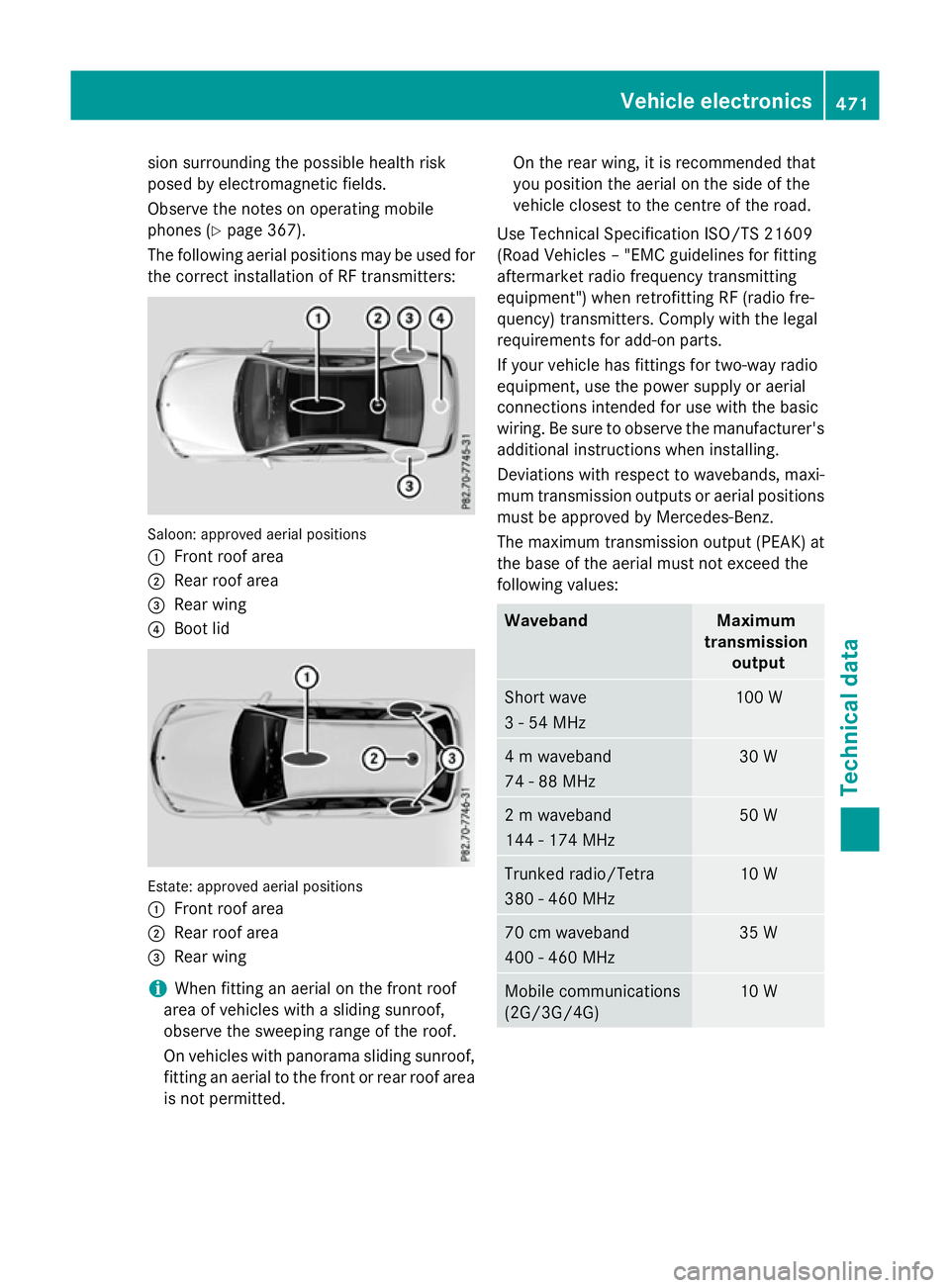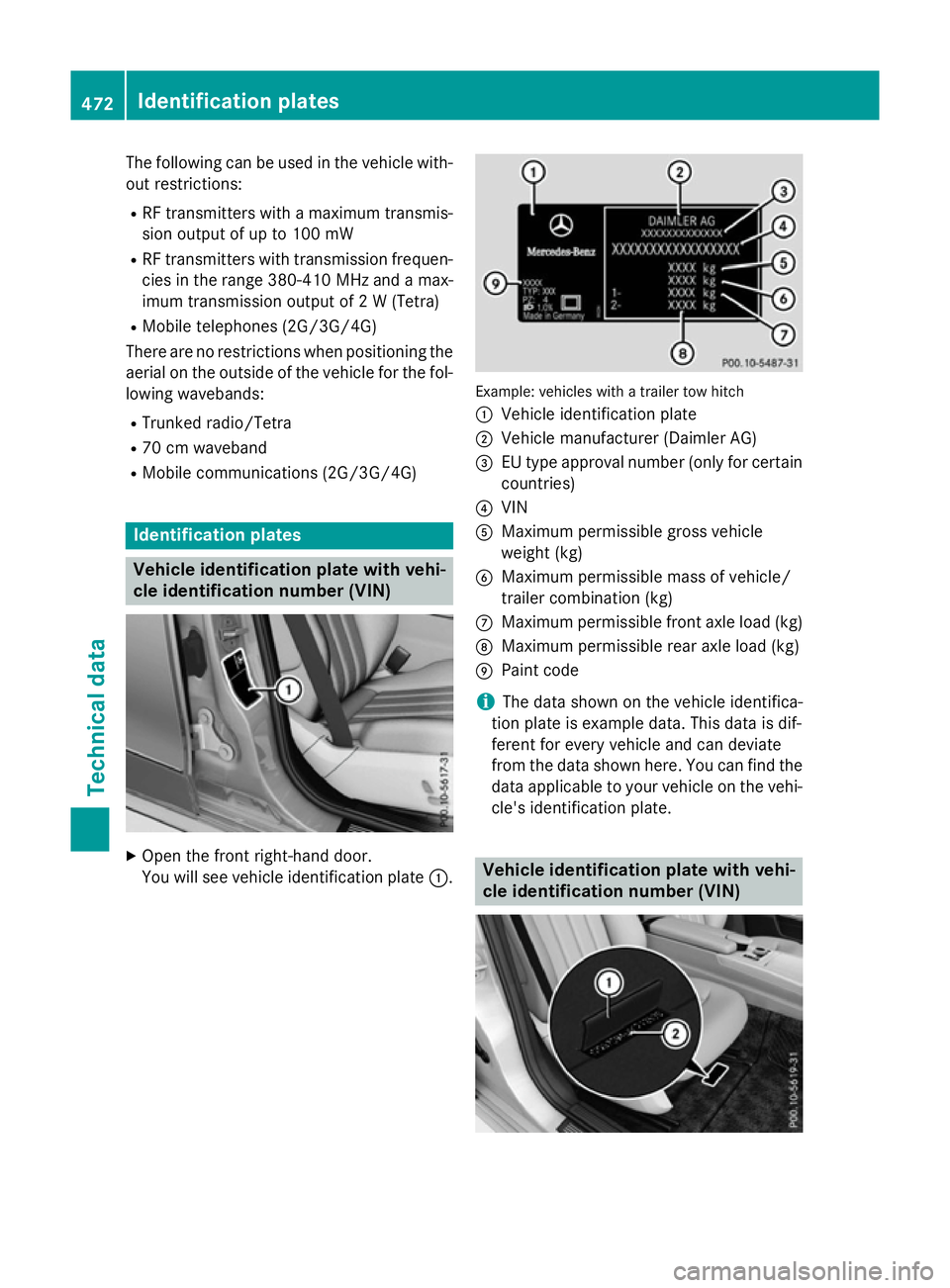2015 MERCEDES-BENZ E-CLASS ESTATE phone
[x] Cancel search: phonePage 427 of 497

phones, two-way radios) that may be being
operated in or near the vehicle.
Checking the tyr epressure electroni-
cally X
Make sure that the key is in position 2
(Y page 179) in the ignition lock.
X Press the =or; button on the steer-
ing wheel to select the Service
Servicemenu.
X Press the 9or: button to select
Tyre pressure
Tyre pressure.
X Press the abutton.
The curren ttyre pressure for each wheel
will be displayed in the multifunction dis-
play.
If the vehicle has been parked for over
20 minutes, the Tyre Tyrepressures
pressures will
willbe
be
displayed after afew minute sof
displayed after afew minute sof
driving
driving message appears.
After ateach-in period, the tyre pressure
monitor automatically detects new wheels or new sensors. As long as aclear allocation of
the tyre pressure values to the individual
wheels is not possible, the Tyre pressure Tyre pressure
monito ractive
monito ractive display message is shown
instead of the tyre pressure display. The tyre
pressures are already being monitored.
If an emergency spare wheel is fitted, for a
few minutes the system may continue to
show the tyre pressure of the wheel that has
been removed. If this occurs, not ethat the
value displayed for the position where the
spare wheel is fitted is not the same as the
curren ttyre pressure of the emergency spare
wheel.
Warning messages of the tyr epressure
monitor If the tyre pressure monitor detects
apres-
sure loss in one or more tyres, awarning mes-
sage is shown in the multifunction display and
the yellow tyre pressure monitor warning
lamp comes on.
R If the Please correc ttyre pressure
Please correc ttyre pressure
message appears in the multifunction dis- play, the tyre pressure in at least one tyre is
too low and must be corrected at the next
opportunity.
R If the Check tyre(s) Check tyre(s) message appears in
the multifunction display, the tyre pressure in one or more tyres has dropped signifi-
cantly and the tyres must be checked.
R If the Warnin gtyre defect
Warnin gtyre defect message
appears in the multifunction display, the
tyre pressure in one or more tyres has drop-
ped suddenly and the tyres must be
checked.
Observ ethe instructions and safety notes in
the display messages in the "Tyres" section
(Y page 322).
If the wheel position sonthe vehicle are inter-
changed, the tyre pressures may be displayed for the wrong position sfor as hort time. After
af ew minutes of driving, this is rectified and
the tyre pressures are displayed for the cor-
rect positions.
Restarting the tyr epressure monitor When you restart the tyre pressure monitor,
all existing warning messages are deleted and
the warning lamps go out. The monitor uses
the currently set tyre pressures as the refer-
enc evalues for monitoring. In most cases, the
tyre pressure monitor will automatically
detec tthe new referenc evalues after you
have changed the tyre pressure. However,
you can also define referenc evalues man-
ually as described here. The tyre pressure
monitor then monitors the new tyre pressure values.
X Use the table on the inside of the fuel filler
flap to ensure that the tyre pressure is set
correctly in all four tyres for the current
operatin gconditions.
Also observe the notes in the section on
tyre pressures (Y page 420).
X Make sure that the key is in position 2in the
ignition lock.
X Press the =or; button on the steer-
ing wheel to select the Service Servicemenu. 424
Tyrep
ressureWheels and tyres
Page 473 of 497

Useful information
i This Owner's Manual describes all mod-
els, series and optional equipment for your
vehicle that were available at the time of
going to press. National variation sare pos-
sible. Not ethat your vehicle may not be
equipped with all of the function sdescri-
bed. This is also the case for system sand
function srelevan ttosafety.
i Read the information on qualified special-
ist workshops: (Y page 27). Information on technical data
G
WARNING
Hybrid vehicles :ensure that you read the
"HYBRID "supplement .You could otherwise
fail to recognise dangers.
You can find current technical data on the
Interne tonour Mercedes‑ Benzhomepage.
i The technical data was determined in
accordance with EU Directives .All data
applies to the vehicle' sstandard equip-
ment .The data may therefore differ for
vehicles with optional equipment .You can
obtain further information from a
Mercedes-Benz Service Centre. Vehicle electronics
Tampering with the engine electron-
ics
! Only have work carried out on the engine
electronics and its associated parts, such
as contro lunits ,sensors, actuating com-
ponents and connector leads, at aqualified
specialist workshop. Vehicle components
may otherwise wear more quickly and the
vehicle' soperatin gpermit may be invalida-
ted. Retrofitting two-way radios and
mobile phones (RF transmitters)
G
WARNING
If RF transmitter sare tampered with or not
properly retrofitted, the electromagnetic radi- ation they emit can interfer ewith the vehicle
electronics. This may jeopardis ethe opera-
tional safet yofthe vehicle. There is arisk of an
accident.
You should have all work on electrical and
electronic components carried out at aquali-
fied specialist workshop. G
WARNING
If you operate RF transmitter sincorrectly in
the vehicle, the electromagnetic radiation
could interfer ewith the vehicle electronics,
e.g.:
R if the RF transmitter is not connected to an
exterior aerial
R the exterior aerial has been fitted incor-
rectly or is not alow-reflection type
This could jeopardis ethe operatin gsafet yof
the vehicle. There is arisk of an accident.
Have the low-reflection exterior aerial fitted at
aq ualified specialist workshop. When oper-
ating RF transmitter sinthe vehicle, always
connec tthem to the low-reflection exterior
aerial.
! The operatin
gpermit may be invalidated if
the instructions for installation and use of
RF transmitter sare not observed.
In particular, the following condition smust
be complied with:
R only approved wavebands may be used.
R observ ethe maximum permissible out-
put in thes ewavebands.
R only approved aerial position smay be
used.
Excessiv elevels of electromagnetic radiation
may cause damage to your health and to the
health of others. The use of an exterior aerial
takes int oconsideration the scientific discus- 470
Vehicle electronicsTechnical data
Page 474 of 497

sion surrounding the possible health risk
posed by electromagnetic fields.
Observe the notes on operating mobile
phones (Y page 367).
The following aerialp ositions may be used for
the correct installation of RF transmitters: Saloon: approved aerial positions
:
Front roof area
; Rear roof area
= Rear wing
? Boot lid Estate: approved aerial positions
:
Front roof area
; Rear roof area
= Rear wing
i When fitting an aerialont
he front roof
area of vehicles with asliding sunroof,
observe the sweeping range of the roof.
On vehicles with panorama sliding sunroof,
fitting an aerialtot he front or rear roof area
is not permitted. On the rear wing, it is recommended that
you position the aerialont he side of the
vehicle closest to the centre of the road.
Use Technical Specification ISO/TS 21609
(RoadV ehicles–"EMC guidelines for fitting
aftermarket radio frequency transmitting
equipment") when retrofitting RF (radio fre-
quency) transmitters. Comply with the legal
requirements for add-on parts.
If your vehicle has fittings for two-way radio
equipment, use the power supplyora erial
connections intended for use with the basic
wiring. Be sure to observe the manufacturer's additional instructions when installing.
Deviations with respect to wavebands, maxi-
mum transmission outputs or aerialp ositions
must be approved by Mercedes-Benz.
The maximum transmission output (PEAK) at
the base of the aerialm ust not exceed the
following values: Waveband Maximum
transmission output Short wave
3-54M
Hz 100 W
4mw
aveband
74 -88M Hz 30 W
2mw
aveband
144 -174 MHz 50 W
Trunked radio/Tetra
380
-460 MHz 10 W
70 cm waveband
400
-460 MHz 35 W
Mobile communications
(2G/3G/4G) 10 WVehicle electronics
471Technical data Z
Page 475 of 497

The following can be used in the vehicle with-
out restrictions:
R RF transmitters with amaximum transmis-
sion output of up to 100 mW
R RF transmitters with transmission frequen-
cies in the range 380-410 MHz and amax-
imum transmission output of 2W(Tetra)
R Mobile telephones (2G/3G/4G)
There are no restriction swhen positionin gthe
aerial on the outside of the vehicle for the fol-
lowing wavebands:
R Trunked radio/Tetra
R 70 cm waveband
R Mobile communications (2G/3G/4G) Identification plates
Vehicle identification platew
ith vehi-
cle identification number (VIN) X
Open the frontr ight-hand door.
You will see vehicle identification plate :. Example: vehicles with
atrailer tow hitch
: Vehicle identification plate
; Vehicle manufacturer (Daimler AG)
= EU type approval number (only for certain
countries)
? VIN
A Maximum permissible gross vehicle
weight (kg)
B Maximum permissible mass of vehicle/
trailer combination (kg)
C Maximum permissible fronta xle load (kg)
D Maximum permissible rear axle load (kg)
E Paint code
i The data shown on the vehicle identifica-
tion plate is example data. This data is dif-
ferent for every vehicle and can deviate
from the data shown here. You can find the
data applicable to your vehicle on the vehi- cle's identification plate. Vehicle identification platew
ith vehi-
cle identification number (VIN) 472
Identification platesTechnical data